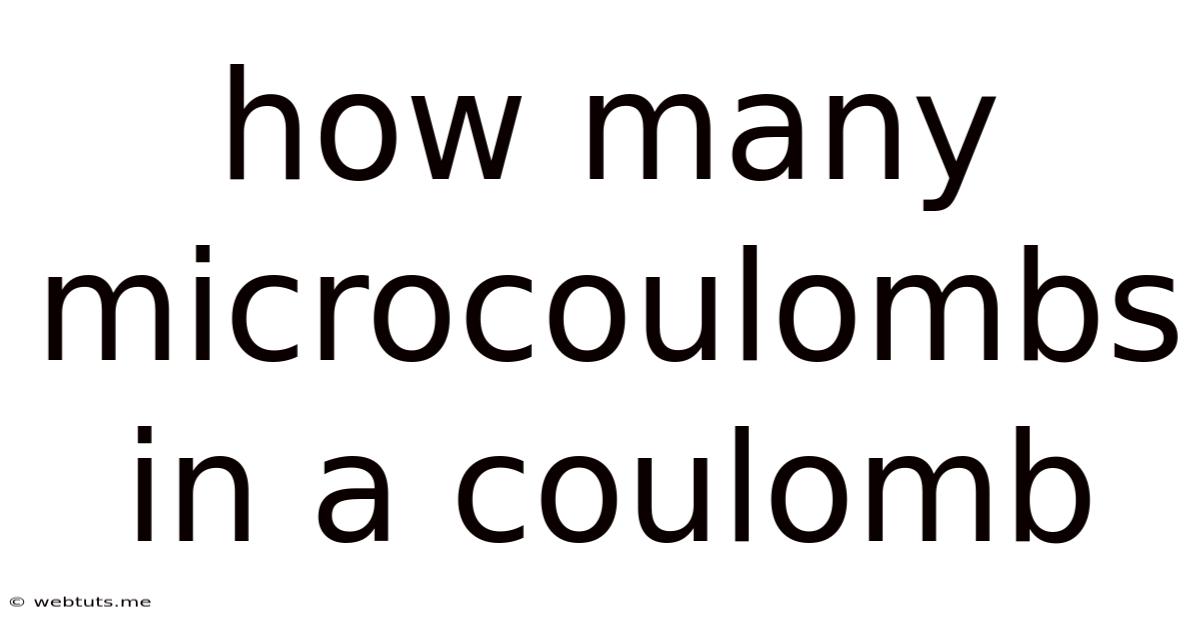How Many Microcoulombs In A Coulomb
Webtuts
May 13, 2025 · 4 min read

Table of Contents
How Many Microcoulombs in a Coulomb? A Deep Dive into Electrical Charge
Understanding the relationship between coulombs and microcoulombs is fundamental to grasping electrical charge and its applications in various fields, from electronics to physics. This comprehensive guide will not only answer the titular question but also delve into the broader context of electrical charge, its measurement, and its significance in our technological world.
Understanding the Coulomb: The Unit of Electrical Charge
The coulomb (C) is the International System of Units (SI) unit of electric charge. It's a measure of the amount of electrical charge carried by a current of one ampere in one second. Imagine it as a fundamental building block representing a specific quantity of electricity. A single coulomb represents a substantial amount of charge; it's the charge carried by approximately 6.24 x 10<sup>18</sup> electrons. This vast number highlights the minuscule nature of individual electron charges.
Think of the coulomb like a liter for volume. Just as a liter is a specific amount of liquid, a coulomb is a specific amount of electrical charge. We use larger and smaller units to measure things more easily depending on the scale; similarly, we often use multiples and submultiples of the coulomb for practicality.
The Microcoulomb: A Smaller Unit of Charge
The microcoulomb (µC) is a submultiple of the coulomb. The prefix "micro" (µ) indicates one millionth (10<sup>-6</sup>). Therefore, there are 1,000,000 microcoulombs in one coulomb. This relationship can be expressed mathematically as:
1 C = 1,000,000 µC or 1 C = 10<sup>6</sup> µC
Using microcoulombs is convenient when dealing with smaller quantities of charge, common in many electronic circuits and applications. It avoids dealing with cumbersomely small decimal numbers. For instance, a charge of 0.000005 C is much easier to express as 5 µC.
Practical Applications and Examples
Understanding the relationship between coulombs and microcoulombs is crucial in several areas:
1. Capacitors:
Capacitors are electronic components that store electrical charge. Their capacitance is often measured in microfarads (µF), which directly relates to the amount of charge they can hold at a given voltage. The charge (Q) stored in a capacitor is given by the equation:
Q = CV
Where:
- Q is the charge in coulombs (or microcoulombs)
- C is the capacitance in farads (or microfarads)
- V is the voltage across the capacitor in volts
For example, a 10 µF capacitor charged to 10 volts will store 100 µC of charge (Q = 10 µF * 10 V = 100 µC).
2. Electrostatics:
Electrostatics deals with static electricity – stationary electrical charges. The forces between charged objects are calculated using Coulomb's Law, which involves charges expressed in coulombs. However, in many electrostatic problems involving smaller objects or charges, using microcoulombs simplifies calculations.
3. Semiconductor Devices:
In semiconductor physics and engineering, the movement of individual electrons and holes (electron vacancies) represents charge flow. While the charge of a single electron is incredibly small (approximately 1.602 x 10<sup>-19</sup> C), dealing with large numbers of electrons in transistors and other semiconductor devices often results in charge quantities best expressed in microcoulombs.
Conversion Between Coulombs and Microcoulombs
Converting between coulombs and microcoulombs is straightforward. Remember the fundamental relationship:
- To convert coulombs to microcoulombs, multiply by 1,000,000 (or 10<sup>6</sup>).
- To convert microcoulombs to coulombs, divide by 1,000,000 (or 10<sup>-6</sup>).
Here are some examples:
-
Example 1: Convert 2.5 C to microcoulombs. 2.5 C * 10<sup>6</sup> µC/C = 2,500,000 µC
-
Example 2: Convert 750,000 µC to coulombs. 750,000 µC / 10<sup>6</sup> µC/C = 0.75 C
-
Example 3: Convert 0.000015 C to microcoulombs. 0.000015 C * 10<sup>6</sup> µC/C = 15 µC
Beyond Coulombs and Microcoulombs: Other Units of Charge
While coulombs and microcoulombs are commonly used, other units exist, depending on the scale of charge being measured:
- Kilocoulombs (kC): 1 kC = 1000 C
- Nanocoulombs (nC): 1 nC = 10<sup>-9</sup> C
- Picocoulombs (pC): 1 pC = 10<sup>-12</sup> C
The choice of unit depends entirely on the context and the magnitude of the charge being considered.
Importance of Accurate Charge Measurement
Accurate measurement of electrical charge is critical in various applications:
- Electronics: Ensuring proper functioning of circuits and preventing damage from electrostatic discharge (ESD).
- Physics: Precise charge measurements are essential for experiments in particle physics, electromagnetism, and other areas.
- Medicine: Accurate charge measurements are vital in medical devices and treatments, such as electrosurgery and radiation therapy.
Conclusion: Mastering the Microcoulomb
Understanding the relationship between coulombs and microcoulombs is a cornerstone of understanding electricity. The ability to seamlessly convert between these units is crucial for anyone working with electrical circuits, electronics, or physics. By grasping this fundamental concept, you can confidently tackle problems involving electrical charge and delve deeper into the fascinating world of electricity and its myriad applications. Remember the key conversion factor: 1 coulomb equals 1,000,000 microcoulombs. This simple relationship unlocks a deeper understanding of the quantitative aspects of electric charge. Further exploring topics like capacitance, Coulomb's Law, and semiconductor physics will solidify your understanding and provide a strong foundation for more advanced concepts in electricity and electronics.
Latest Posts
Latest Posts
-
How Many Feet Are In 132 Inches
May 13, 2025
-
Cuanto Es 300 Libras En Kilos
May 13, 2025
-
1 Teaspoon Is How Many Grams Of Sugar
May 13, 2025
-
30 Days From December 12 2024
May 13, 2025
-
How Many Hours Are There In One Week
May 13, 2025
Related Post
Thank you for visiting our website which covers about How Many Microcoulombs In A Coulomb . We hope the information provided has been useful to you. Feel free to contact us if you have any questions or need further assistance. See you next time and don't miss to bookmark.